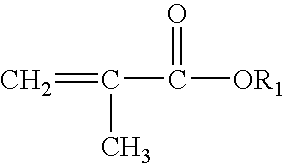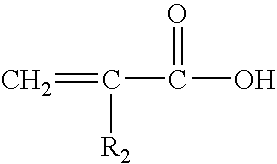Polymeric stabilizing agent for water-in-oil polymerization processes
a polymer stabilizing agent and water in-oil technology, applied in the field of stabilizing agents, can solve the problems of non-uniform mixing, heat transfer limitations, scale synthesis, etc., and achieve the effects of high molecular weight, good stability, and high solid conten
- Summary
- Abstract
- Description
- Claims
- Application Information
AI Technical Summary
Benefits of technology
Problems solved by technology
Method used
Image
Examples
example 1a
Preparation of a Stabilizing Agent
[0069] A polymeric stabilizing agent, (IB 14 in Table 1a) was polymerized based on 86 mol % of a mixture of methacrylates having C16 or C18 alkyl chain length (with a ratio of C16:C18 of 25:75) and 14 mol % of acrylic acid. 20 parts of the stabilizing agent IB 14 are dissolved in 80 parts of aliphatic hydrocarbon (Isopar M) as a solvent. The solution is charged in a 0.5 L glass rector, equipped with mechanical stirrer, cooling-heating jacket and connected to a nitrogen line. The reaction mixture is purged / degassed continuously for 1 hour with nitrogen, the temperature is increased up to 60° C. and the reaction is initiated with addition of 0.0005 parts of 2,2′-azobis(2,4dimethylvaleronitrile). After 3 hours the temperature is increased up to 90° C. and is kept constant for another 5 hours to complete the polymerization reaction. The obtained copolymers are used in a solution as received.
example 1b
Preparation of Acrylamide-Sodium Acrylate Copolymer by Inverse-Emulsion Copolymerization
[0070] This example illustrates the synthesis of acrylamide copolymer comprising 20 mol percent sodium acrylate, based on the total molar monomer content.
[0071] To a vessel equipped with a stirrer are added 213.2 grams of aliphatic solvent, 12 grams of sorbitan monoisostearate, 8 grams of polyoxyethylenated(20)sorbitan trioleate, and 4.2 grams dry polymer of the aforementioned stabilizing agent from example 1a (EB 14) as 20 wt % solution in aliphatic hydrocarbon. The mixture is stirred at 300 rpm for 5 minutes.
[0072] In a separate vessel also equipped with a stirrer, the aqueous phase is prepared containing 285.5 grams of acrylamide, 72.4 grams of acrylic acid, 0.25 grams of EDTA (sodium salt), 0.2 grams of potassium bromate, 10 grams of ammonium chloride, and 329.9 grams of demineralized water.
[0073] The aqueous phase is stirred for about 30 minutes at 250 rpm and is buffered to a pH of 7.0 ...
examples 2-4
[0074] The aqueous phase contains: 285.5 grams of acrylamide, 72.3 grams of acrylic acid, 0.2 grams of potassium bromate, 0.25 grams EDTA (sodium salt), 9.8 grams of ammonium chloride, 0.2 grams of octadecyltrimethylammonium chloride, and 329.9 grams of demineralized water. The aqueous phase is adjusted to a pH of 7.0 with 50 wt % solution of sodium hydroxide.
[0075] The continuous phase contains respectively: 209.2 grams of aliphatic hydrocarbon, 12 grams of sorbitan monostearate, 8 grams of polyoxyethylenated(20)sorbitan trioleate and 5.0 grams dry polymer of stabilizing agent from example 1a (IB 14) as a 20 wt % solution in Isopar-M.
[0076] The procedure for preparing the emulsion and the polymerization reaction is the same as in Example 1.
[0077] The molecular weight characteristics are improved compared with the Example 1 and the final emulsions are substantially free of coagulum. The intrinsic viscosities are listed in Table 2, and were measured at 25° C. in 0.5 M NaCl.
TABLE...
PUM
| Property | Measurement | Unit |
|---|---|---|
| weight percent | aaaaa | aaaaa |
| weight percent | aaaaa | aaaaa |
| mol % | aaaaa | aaaaa |
Abstract
Description
Claims
Application Information
 Login to View More
Login to View More - R&D
- Intellectual Property
- Life Sciences
- Materials
- Tech Scout
- Unparalleled Data Quality
- Higher Quality Content
- 60% Fewer Hallucinations
Browse by: Latest US Patents, China's latest patents, Technical Efficacy Thesaurus, Application Domain, Technology Topic, Popular Technical Reports.
© 2025 PatSnap. All rights reserved.Legal|Privacy policy|Modern Slavery Act Transparency Statement|Sitemap|About US| Contact US: help@patsnap.com



